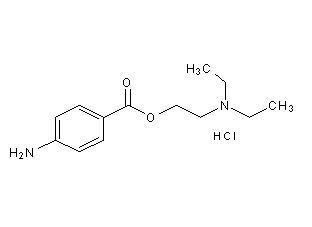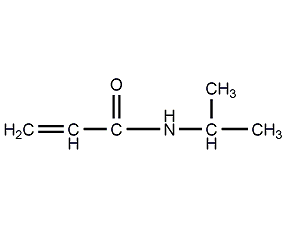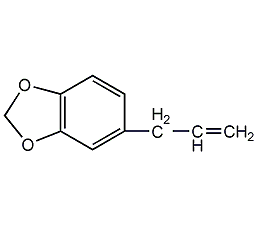
Structural formula
| Business number | 014E |
|---|---|
| Molecular formula | C13H21N2O2Cl |
| Molecular weight | 272.78 |
| label |
4-Aminobenzoic acid-2-(diethylamino)ethyl ester monohydrochloride, 2-Diethylaminoethyl p-aminobenzoate hydrochloride, 2-Diethylaminoethyl 4-aminobenzoate hydrochloride, 2-(Diethylamino)ethyl p-aminobenzoate monohydrochloride, Procain Hydrochloride, Procaine hydrochloride, H2NC6H4CO2CH2CH2N(C2H5)2·HCl |
Numbering system
CAS number:51-05-8
MDL number:MFCD00013000
EINECS number:200-077-2
RTECS number:DG2275000
BRN number:3917802
PubChem number:24278665
Physical property data
1. Properties: Colorless monoclinic or triclinic hexagonal flaky crystals. Odorless. Has a numbing smell. Stable in air. It easily turns yellow when exposed to light.
2. Density (g/mL, 25/4℃): Undetermined
3. Relative vapor density (g/mL, air=1): Undetermined
4. Melting point (ºC): 153~156
5. Boiling point (ºC, normal pressure): Undetermined
6. Boiling point (ºC, 5.2kPa): Undetermined
7. Refractive index: Undetermined
8. Flash point (ºC): Undetermined
9. Specific rotation (º): Undetermined Determined
10. Autoignition point or ignition temperature (ºC): Not determined
11. Vapor pressure (kPa, 25ºC): Not determined
12. Saturated vapor pressure (kPa, 60ºC): Undetermined
13. Heat of combustion (KJ/mol): Undetermined
14. Critical temperature (ºC): Undetermined
15. Critical pressure (KPa): Undetermined
16. Log value of oil-water (octanol/water) partition coefficient: Undetermined
17. Explosion upper limit ( %, V/V): Undetermined
18. Lower explosion limit (%, V/V): Undetermined
19. Solubility: 1g product dissolves in 1ml of water, 30ml ethanol. Slightly soluble in chloroform, almost insoluble in ether. The pH of 0.1mol/L aqueous solution is 6.0. The aqueous solution can be boiled for sterilization.
Toxicological data
None
Ecological data
None
Molecular structure data
1. Molar refractive index: Not available
2. Molar volume (cm3/mol): Not available
3. Isotonic specific volume ( 90.2K): Not available
4. Surface layout� (dyne/cm): Not available
5. Polarizability (10-24cm3): Not available
Compute chemical data
1. Reference value for hydrophobic parameter calculation (XlogP):
2. Number of hydrogen bond donors: 2
3. Number of hydrogen bond acceptors: 4
4. Number of rotatable chemical bonds: 7
5. Number of tautomers: 2
6. Topological molecular polar surface area (TPSA): 55.6
7. Number of heavy atoms: 18
8. Surface charge: 0
9. Complexity: 222
10. Number of isotope atoms: 0
11. Determine the number of atomic stereocenters: 0
12. Uncertain number of atomic stereocenters: 0
13. Determine the number of chemical bond stereocenters Number: 0
14. Number of uncertain chemical bond stereocenters: 0
15. Number of covalent bond units: 2
Properties and stability
None
Storage method
This product should be sealed and stored away from light.
Synthesis method
None
Purpose
Pharmaceuticals. Local anesthetic.
extended-reading:https://www.newtopchem.com/archives/680extended-reading:https://www.newtopchem.com/archives/582extended-reading:https://www.bdmaee.net/jeffcat-dmp-catalyst-cas106-58-1-huntsman/extended-reading:https://www.newtopchem.com/archives/39757extended-reading:https://www.newtopchem.com/archives/1035extended-reading:https://www.cyclohexylamine.net/non-emissive-polyurethane-catalyst-dabco-ne1060-catalyst/extended-reading:https://www.newtopchem.com/archives/44468extended-reading:https://www.bdmaee.net/methyl-tin-mercaptide-cas26636-01-1-coordinated-thiol-methyltin/extended-reading:https://www.bdmaee.net/wp-content/uploads/2022/08/67.jpgextended-reading:https://www.cyclohexylamine.net/polyurethane-catalyst-sa102-catalyst-sa102/








